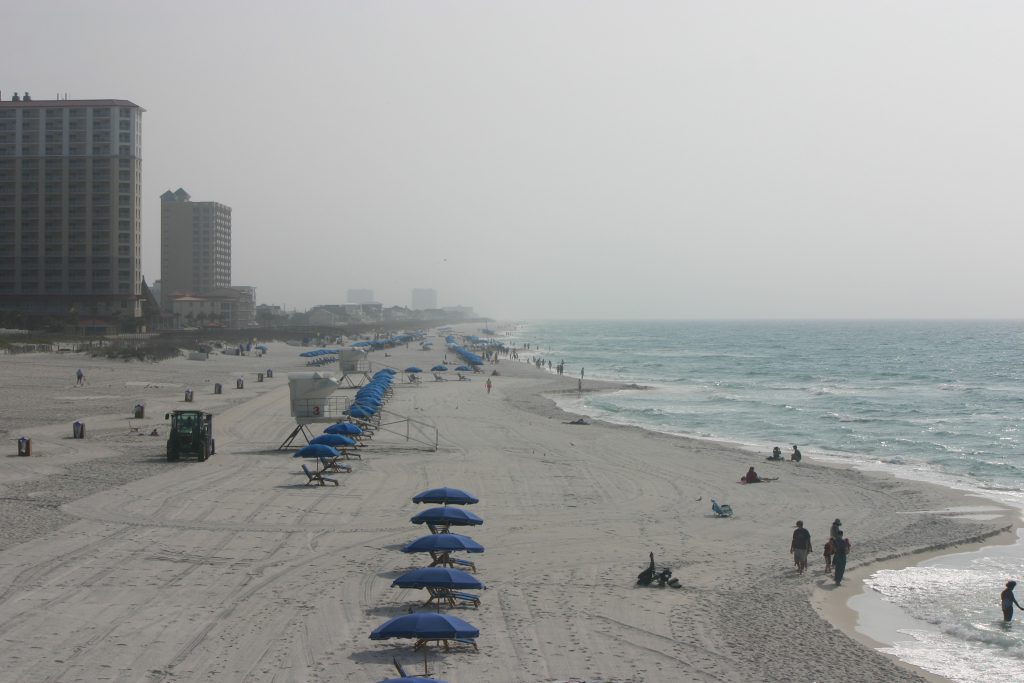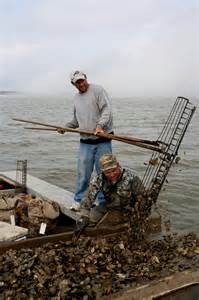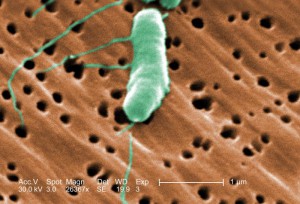
Recent news reports have Panhandle Beaches trending on social media. Beaches are open and ready for the holiday weekend. Here’s information to help make sure you are ready too. Photo by Florida Sea Grant.
The threat of bacteria in coastal waters can be scary and a challenge to understand. Here is information that helps clarify the threat to beach visitors and recreational users of marine waters. This is a good opportunity to think about bacteria exposure risks related to the coastal environment that we can control. It is important to remember the probability of severe illness in a normal healthy individual is very low.
There are two different un-related groups of bacteria species that often are cited in the news. One general group is fecal coliform and the other group are marine specific known as Vibrio.
Fecal coliform including Enterococci bacteria are used by public health managers as indicators of water quality. High levels of these bacteria can indicate an elevated health risk for beach visitors. For some individuals contact in impacted waters can result in gastrointestinal issues like nausea, vomiting, stomachache, diarrhea, headache or fever. Other symptoms might include rashes, sore throat, ear ache, and other cold-like or upper respiratory symptoms.
When “no-swimming” advisories are posted you can avoid these concerns by following warning and guidance information. Many times advisories are for specific locations due to storm run-off and water circulation patterns. If an area has a warning or is closed, usually there are better choices for swimming activities nearby. The Florida Department of Health has an established testing of many of Florida’s coastal swimming areas. The latest guidance information can be found at http://www.floridahealth.gov/environmental-health/beach-water-quality
On the other hand, Vibrio exposure that results in illness is potentially more severe. The US Centers for Disease Control and Prevention now estimate 80,000 Vibrio illnesses and 100 deaths occur annually in the United States. In perspective, The Clean Beaches Coalition estimates 180 million Americans annually make 2 billion visits to ocean, gulf and inland beaches.
According Georgia Sea Grant’s SafeOysters.org website and research, many Vibrio infections are not reported and usually do not cause serious or life-threatening illness in healthy people, although they may cause gastroenteritis (nausea, abdominal pain, vomiting, and/or diarrhea) or cellulitis (skin infection). For a Vibrio infection to occur there must be an entry point into the body. This usually is either through water entering an open wound or eating raw or undercooked seafood.
Symptoms of infection due to consumption of raw or undercooked seafood often develop in 12 to 48 hours and may include:
-
Fever/chills
-
Nausea/stomach pain/vomiting
-
Diarrhea
Individuals with weakened immune systems, chronic diseases or conditions, or undergoing certain medical treatments (see list below) are more susceptible to Vibrio vulnificus infections and are also more likely to become seriously ill or die from them. The fatality rate may be as high as 61% for Vibrio vulnificus infections in people that have been diagnosed with one or more of the following health conditions:
-
Liver disease (from cirrhosis, hepatitis, or cancer)
-
Diabetes
-
Alcoholism
-
Kidney disease or failure
-
Cancer (includes lymphoma, leukemia, and Hodgkin’s disease)
-
HIV/AIDS
-
Stomach disorders including surgery, taking acid reflux medication or antacids
-
Hemochromatosis (iron overload disease)
* If you are unsure of your risk, consult your doctor. You can always indulge in great oyster recipes that are fully cooked like Oyster Rockefeller or oyster chowder.
Perhaps one of the most common group of listed individuals are those taking acid reflux or heartburn medications. This would also include antacids and prescription medications for acid reflux and other common digestive conditions. Many of these medications work by reducing acid which can potentially increase pH in the digestive system. This lowers the natural defense barrier to several foodborne bacteria including Vibrio. If you take these medications do not eat raw or under cooked seafood. If you have any question about your risk, consult your doctor.

An oysterman uses his 11 foot long tongs to collect oysters from the bottom of Apalachicola Bay
Photo: Sea Grant
Shellfish harvesting is managed by the Florida Department of Agriculture and Consumer Services – Division of Aquaculture and Florida Fish and Wildlife Commission. This is done in cooperation with Florida’s certified shellfish harvesters and processors. While Vibrio counts may be higher in warmer weather, shellfish harvest areas are monitored all year. A system of specific harvest protocols are consistently maintained. Florida’s regulatory agencies and seafood industries work together with the goal of having the safest shellfish supply at all times of the year.
As mentioned earlier, Vibrio can also enter the body through open wounds. Vibrio is sometimes misnamed as “flesh-eating” bacteria. “Flesh-eating” is not a medical term and was likely derived from the fact that tissue death, or necrosis, can occur during advanced, late stages of infection around a wound if it is left untreated, especially in those with weakened immune systems (Oliver 2005). The best advice is to seek medical attention early if you experience any of these symptoms or have suffered cut or puncture injury in coastal waters. (See Vibrio FAQs from UF/IFAS and Florida Sea Grant)
Wound infection symptoms may develop within 3 to 24 hours and include:
-
Rapid swelling, pain, and reddening of skin around wound (present in 100% of infections)
-
Large blisters, die-off of tissue around wound (30 – 50% of infections)
-
Gangrene (<10%)
If Vibrio vulnificus infections are left untreated in people at risk for serious infection, symptoms may quickly increase in severity and include:
-
Fluid accumulation, especially in legs
-
Blood-filled large blisters, mainly on extremities
-
Septicemia (bacteria enter and spread through blood stream)
-
Shock (rapid drop in blood pressure)
-
Death
For additional information and details please visit SafeOysters.org
Here are some final thoughts and advice:
-
Remember the majority of healthy individuals will not have any problems.
-
If you are recovering from illness know your limits and use the above resources to make informed decisions to protect your health.
-
Plan your beach vacation for safety but then confidently relax and enjoy the experience.
-
For additional beach safety and enjoyment of our natural resources see our other articles on the UF/IFAS Panhandle Outdoors website.

A great blue heron at sunset stalks the shoreline ready for his next meal. Scenes like this await coastal visitors. It’s an experience like nowhere else. Photo by the author.
An Equal Opportunity Institution. UF/IFAS Extension, University of Florida, Institute of Food and Agricultural Sciences, Nick T. Place, dean for UF/IFAS Extension. Single copies of UF/IFAS Extension publications (excluding 4-H and youth publications) are available free to Florida residents from county UF/IFAS Extension offices.
Latest posts by Scott Jackson (see all)
- Stem to Stern (Northwest Florida November 2, 2023) - March 28, 2024
- Gearing up for Red Snapper - July 21, 2023
- ¡Conviértase un cuidador de las vieiras (“Scallop Sitter”)! - October 7, 2022


